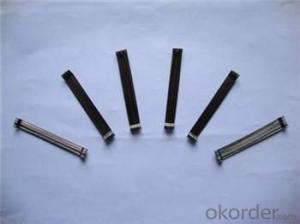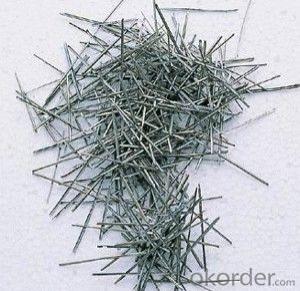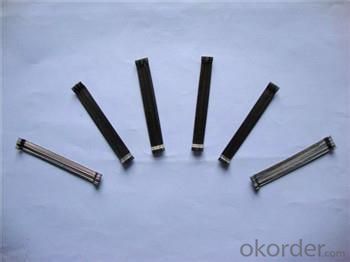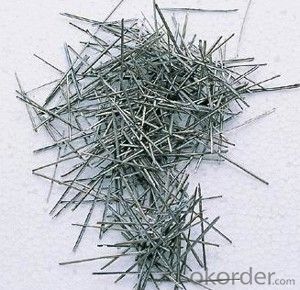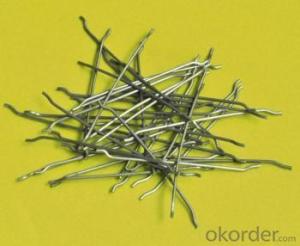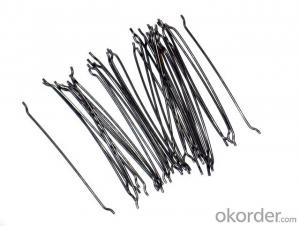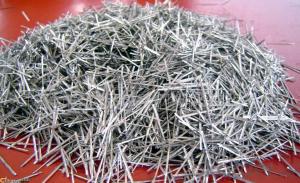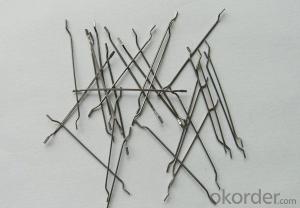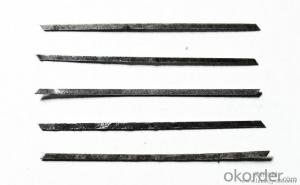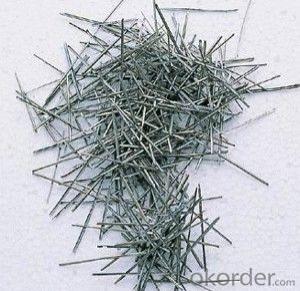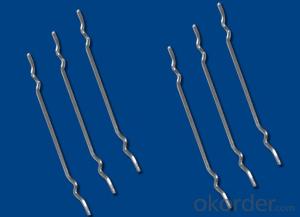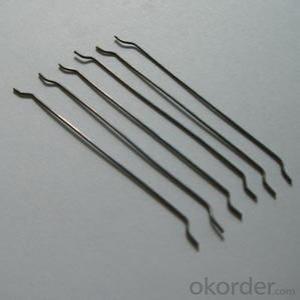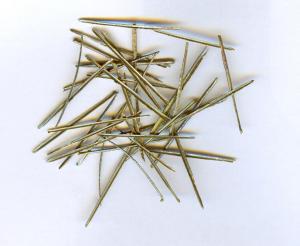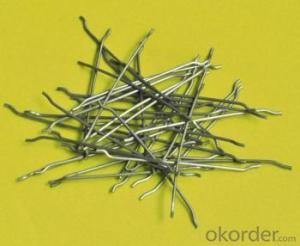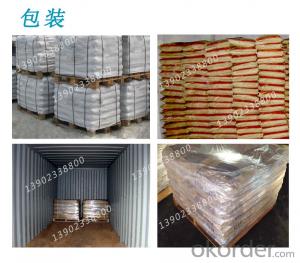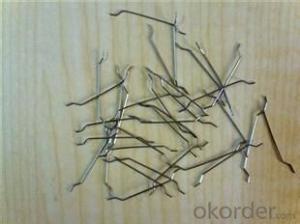Melt Extract Stainless Steel Fiber for Construction and Concrete from China
- Loading Port:
- Tianjin
- Payment Terms:
- TT OR LC
- Min Order Qty:
- 1000 kg
- Supply Capability:
- 250000 kg/month
OKorder Service Pledge
OKorder Financial Service
You Might Also Like
Quick Details
type: steel fiber
usege: concrete of construction
material: steel wire
shape: hooked end,straight middle round fiber
appearance: clear and bright
Place of Origin: Shandong, China (Mainland)
Model Number: hooked steel fiber
Product features
steel fiber for conatruction and concrete reinforcement,widely uesd in concrete to improve its stabality
end hooked steel fiber ,with its high tensile strength ,good scattering and good combination with cenment material
concrete steel fiber is specifically designed to enhance concrete in its hardened state ,the uniform distribution of steel fibers throughout the concrete greatly improve concrete bonding and tensile strengh ,addtionally it provides eceptional load stability and durability ,as reliable and efficient concrete reinforement materisl ,it is widely used in buildings ,bridges,thin roof engineering ,highy way etc.
Specifications
Length :20-60mm
Diameter :0.5-1.2mm
tensile strength :>1100Mpa
type :hooked end ,straight round fiber
appearance : clear and bright
Picture
WAVE STEEL FIBER
HOOK-END STEEL FIBER
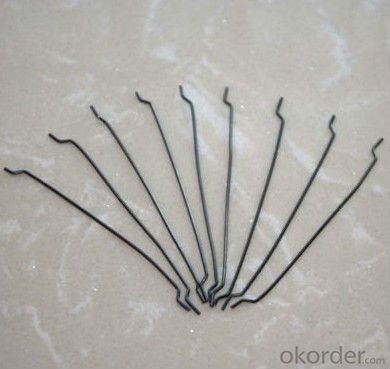
GLUED STEEL FIBER
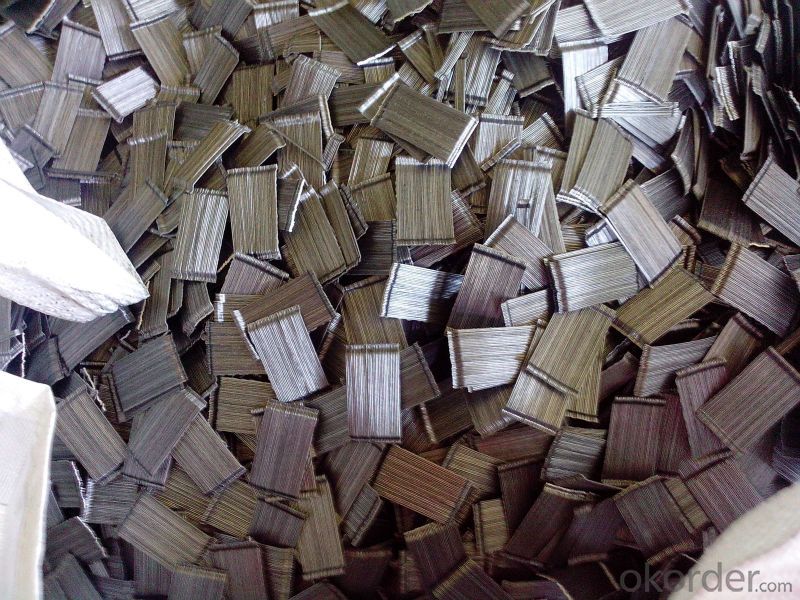
FAQ
we can produce any type steel fiber and of course we can make production according to your requirement
we have specilize in this field for almost 10 years ,with good quality and competitive price
- Q: Does melt extract stainless steel fiber have a high resistance to corrosion?
- Yes, melt extract stainless steel fiber has a high resistance to corrosion. Stainless steel is known for its excellent corrosion resistance due to the presence of chromium in its composition, which forms a protective oxide layer on the surface of the steel. This oxide layer acts as a barrier to prevent the steel from coming into contact with corrosive substances, thereby enhancing its resistance to corrosion. Melt extract stainless steel fibers are made using a process called melt extraction, which ensures the fibers retain the desirable properties of stainless steel, including its corrosion resistance. Therefore, melt extract stainless steel fibers are highly resistant to corrosion, making them suitable for applications in harsh environments, such as marine, chemical, and industrial settings.
- Q: Is melt extract stainless steel fiber compatible with all types of concrete surface finishes?
- No, melt extract stainless steel fiber may not be compatible with all types of concrete surface finishes. It is important to consider the specific requirements and characteristics of the surface finish and consult with a professional to determine its compatibility with the fiber.
- Q: What are the limitations of using melt extract stainless steel fiber in concrete?
- One limitation of using melt extract stainless steel fiber in concrete is the cost. Stainless steel fibers can be more expensive compared to other types of fibers, such as polypropylene or glass fibers. This can increase the overall cost of using stainless steel fiber in concrete construction projects. Another limitation is the potential for corrosion. While stainless steel is known for its corrosion resistance, in certain aggressive environments, such as chloride-rich conditions, it can still corrode over time. This corrosion can weaken the fibers and diminish their effectiveness in reinforcing the concrete. Additionally, the mixing and distribution of stainless steel fibers in the concrete can be challenging. The fibers tend to clump together and can be difficult to disperse evenly throughout the concrete mixture. This uneven distribution can result in inconsistent reinforcement and reduced performance. Lastly, the addition of stainless steel fibers can increase the viscosity of the concrete mixture, making it harder to pump and place. This can lead to difficulties in achieving proper compaction and workability, especially in complex and congested areas of construction. Overall, while melt extract stainless steel fibers offer enhanced strength and durability to concrete, their higher cost, potential for corrosion, challenges in mixing and distribution, and impact on workability are important limitations to consider when using them in concrete applications.
- Q: How does melt extract stainless steel fiber improve the resistance to seismic loading in shotcrete?
- Melt extract stainless steel fiber improves the resistance to seismic loading in shotcrete by enhancing the overall structural integrity and ductility of the material. The high tensile strength and flexibility of the fibers help to distribute the energy generated during seismic events more uniformly, reducing the likelihood of crack formation and propagation. This reinforcement also enhances the bond between the shotcrete and the substrate, providing increased resistance to shear forces and improving the overall durability and performance of the shotcrete system under seismic loading conditions.
- Q: Can melt extract stainless steel fiber be used in high-performance shotcrete mixtures?
- Yes, melt extract stainless steel fiber can be used in high-performance shotcrete mixtures. The addition of stainless steel fibers enhances the strength, durability, and crack resistance of the shotcrete, making it suitable for demanding applications where high performance is required.
- Q: How does melt extract stainless steel fiber affect the rheology of self-compacting concrete?
- The rheology of self-compacting concrete is greatly influenced by the inclusion of melt extract stainless steel fibers. Rheology pertains to the flow characteristics and behavior of a substance, and in the case of self-compacting concrete, it determines its ability to flow and fill intricate forms without mechanical consolidation. The addition of melt extract stainless steel fibers to self-compacting concrete serves as reinforcement, enhancing its mechanical properties. These fibers enhance the structural integrity of the concrete matrix by imparting tensile strength, crack resistance, and improved ductility. This reinforcement effect leads to improved rheological properties of self-compacting concrete. Reducing segregation and bleeding is one of the primary impacts of melt extract stainless steel fibers on the rheology of self-compacting concrete. The fibers aid in the uniform distribution of aggregates, preventing their settlement and resulting in a more homogeneous mixture. This reduces the risk of particle segregation during pouring and casting, resulting in improved flowability and stability of the concrete. In addition, the presence of stainless steel fibers improves the viscosity and yield stress of self-compacting concrete. The fibers form a network within the concrete mixture, increasing its internal friction and resistance to flow. As a result, the slump flow decreases and the concrete exhibits increased resistance to deformation, enabling it to maintain its shape and stability even under its own weight. Moreover, melt extract stainless steel fibers can enhance the cohesiveness and filling capability of self-compacting concrete. The fibers create a bridge between the cementitious matrix and the aggregates, improving their bond. This leads to better workability and flowability, allowing the concrete to effortlessly fill intricate and congested areas without the need for vibration or compaction. In conclusion, melt extract stainless steel fibers positively impact the rheology of self-compacting concrete by reducing segregation and bleeding, improving viscosity and yield stress, and enhancing cohesiveness and filling capability. These fibers contribute to the overall performance and durability of self-compacting concrete by providing reinforcement and improving its structural integrity.
- Q: Is melt extract stainless steel fiber suitable for use in high-temperature applications?
- Yes, melt extract stainless steel fiber is suitable for use in high-temperature applications. This type of fiber is specifically designed to withstand extreme heat and maintain its structural integrity. It has a high melting point and excellent resistance to oxidation, making it ideal for use in environments with elevated temperatures. Melt extract stainless steel fiber can be used in applications such as furnace linings, kilns, and high-temperature insulation. It provides reinforcement and enhances the overall strength of the material it is incorporated into, making it a reliable choice for high-temperature applications.
- Q: How is melt extract stainless steel fiber produced?
- Specialized manufacturing processes are used to produce melt extract stainless steel fiber. Initially, high-quality stainless steel alloy is melted in a furnace at extremely high temperatures. The molten steel is then forced through a spinneret, which is a fine nozzle with multiple small holes. As the molten steel passes through these holes, it solidifies and forms thin fibers. After the fibers are formed, they are rapidly cooled and solidified by passing them through a cooling chamber or a quench bath. This ensures that the fibers maintain their desired shape and strength. Once cooled, the fibers are gathered and further processed to eliminate any impurities or contaminants. Typically, the collected stainless steel fibers are cut into shorter lengths to enhance their usability in various applications. They can also undergo additional processing to modify their surface properties, such as applying a protective layer or different surface treatments. The melt extract process allows for the production of stainless steel fibers that have consistent dimensions and properties. These fibers possess excellent tensile strength, corrosion resistance, and high thermal conductivity, making them suitable for a broad range of applications. They are commonly utilized in industries such as concrete reinforcement, refractories, filtration systems, and as conductive additives.
- Q: What are the different quality standards and certifications for melt extract stainless steel fiber?
- There are several quality standards and certifications that are relevant to melt extract stainless steel fiber. These standards ensure that the fiber meets specific criteria and requirements, ensuring its quality and performance. Some of the most common quality standards and certifications for melt extract stainless steel fiber include: 1. ISO 9001: This is an international standard for quality management systems. It ensures that the manufacturer has implemented a quality management system that consistently meets customer requirements and complies with applicable regulations. 2. ASTM International: ASTM International is a globally recognized standards development organization. They have developed several standards specifically for stainless steel fibers, such as ASTM A820 for steel fibers for fiber-reinforced concrete and ASTM A1094 for steel fibers for concrete reinforcement. 3. EN Eurocodes: The Eurocodes are a set of European standards for the design of structures. EN 14889-1 is the European standard specifically for steel fibers for concrete reinforcement. It provides requirements for the mechanical properties, dimensions, and durability of the fibers. 4. AISI: The American Iron and Steel Institute (AISI) is an association of North American steel producers. They have developed a specification for stainless steel fibers, known as AISI 304 or AISI 316, which specifies the chemical composition, mechanical properties, and other characteristics of the fiber. 5. CE Marking: CE marking is a mandatory conformity marking for certain products sold within the European Economic Area (EEA). It indicates that the product complies with the essential health, safety, and environmental requirements set out in European Union directives. 6. ICC-ES: The International Code Council Evaluation Service (ICC-ES) provides evaluation reports and certifications for building products. They have developed evaluation criteria for steel fibers used in concrete reinforcement, ensuring that they meet specific performance and safety requirements. It is important to note that the specific quality standards and certifications may vary depending on the intended application of the melt extract stainless steel fiber. It is recommended to consult the manufacturer or supplier to determine the applicable standards and certifications for a particular product.
- Q: How does melt extract stainless steel fiber affect the abrasion resistance of concrete?
- Melt extract stainless steel fiber is known for significantly enhancing the abrasion resistance of concrete. When added to concrete mixes, these fibers create a three-dimensional reinforcement network within the material, improving its overall strength and durability. The unique properties of stainless steel, such as high tensile strength and excellent corrosion resistance, contribute to the enhanced abrasion performance of the concrete. The addition of melt extract stainless steel fiber to concrete helps to reduce the formation of microcracks and control the propagation of existing cracks. As a result, the concrete becomes more resistant to wear and tear caused by abrasion. The fibers act as reinforcement, bridging the gaps between aggregates and providing additional tensile strength to the concrete. By incorporating stainless steel fibers, the concrete gains a higher resistance to surface erosion, impact, and friction. This is particularly beneficial in high-traffic areas, such as industrial floors, highways, parking lots, and airports, where abrasion is a common issue. The improved abrasion resistance ensures that the concrete remains intact and maintains its structural integrity over an extended period. Furthermore, melt extract stainless steel fibers also enhance the overall lifespan of concrete structures. By reducing the need for repairs and maintenance due to abrasion damage, these fibers help to prolong the service life of concrete, resulting in cost savings and reduced environmental impact. In summary, melt extract stainless steel fiber greatly enhances the abrasion resistance of concrete by reinforcing the material, reducing crack formation, and improving its overall strength and durability. This makes it an excellent choice for applications where abrasion is a concern, leading to longer-lasting and more resilient concrete structures.
Send your message to us
Melt Extract Stainless Steel Fiber for Construction and Concrete from China
- Loading Port:
- Tianjin
- Payment Terms:
- TT OR LC
- Min Order Qty:
- 1000 kg
- Supply Capability:
- 250000 kg/month
OKorder Service Pledge
OKorder Financial Service
Similar products
Hot products
Hot Searches
Related keywords
